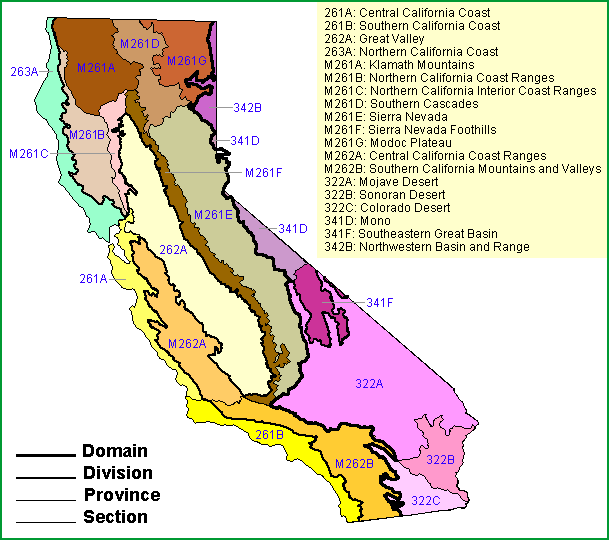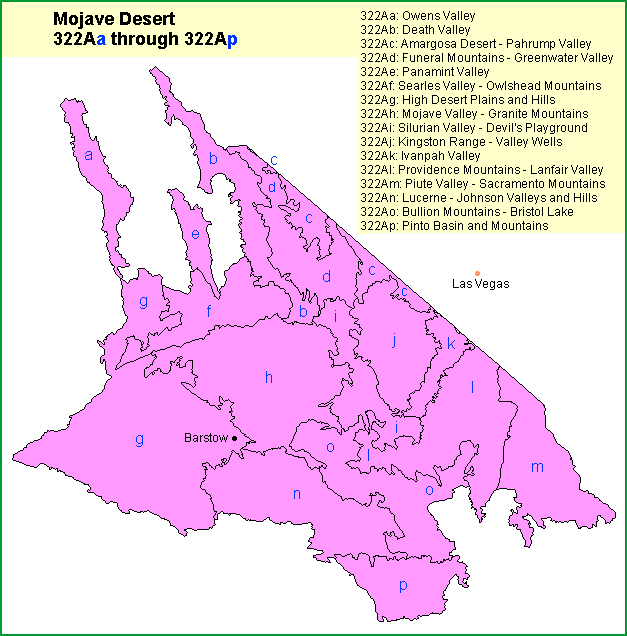 | Mojave Desert |
|
|
http://www.fs.fed.us/r5/projects/ecoregions/322a.htm
Section 322A
Mojave Desert
This section is the hot part of the Basin and ranges from the southern end of the Sierra Nevada and the north-northeastern side of the Transverse Ranges to Nevada and Arizona. Most of it is in MLRA 30, but some is in MLRA 29.
Geomorphology. Widely separated short ranges in desert plains. Contains isolated mountains, plateaus, alluvial fans, playas, basins and dunes. Basin and Range geomorphic province (Mojave Desert).
Lithology. Cenozoic nonmarine sedimentary and granitic rocks and alluvial deposits, and precambrian rocks of all types.
Soil Taxa. Aridisols and Entisols in combination with thermic or hyperthermic soil temperature regimes and aridic soil moisture regimes on foothills and valleys. Contains areas with salt affected soils. Aridisols and Entisols in combination with thermic or mesic soil temperature regimes, and aridic or xeric soil moisture regimes on mountains.
Vegetation. Predominant potential natural communities includes the Creosote bush series, Creosote bush - white bursage series, Allscale series, Mixed saltbush series, Iodine bush series, Joshua Tree series, Shadscale series, Black bush series, Mesquite series, California Juniper series, Singleleaf pinyon - Utah juniper series and White fir series (high peaks).
The following series are found throughout the section and are not restricted to or extensive in any subsection. Series dominated by exotic plants are not listed under subsections unless they are extensive and stable.
Series dominated by exotic plants: California annual grassland series, Common reed series and Tamarisk series.
Series that can occur in all subsections, but are not extensive: Bulrush series, Bulrush - cattail series, Cattail series, Cordgrass series, Duckweed series, Mosquito fern series, One-sided bluegrass series, Pondweeds with floating leaves series, Pondweeds with submerged leaves series, Sedge series and Spikerush series.
Series restricted to riparian settings: Arrow weed series, Black willow series, Fremont cottonwood series, Mixed willow series, Mulefat series, Narrowleaf willow series and Red willow series.
Fauna. Mammals include desert bighorn sheep, desert kit fox, coyote, spotted skunk, spotted bat, black-tailed jackrabbit, ground squirrels, kangaroo rat and white footed mouse. Birds includes eagles, hawks, owls, quail, roadrunners, finches, warblers and orioles. Reptiles include desert tortoise, several species of rattlesnakes and chuckawalla lizard.
Elevation. 280 feet below sea level to 7900 feet above sea level.
Precipitation. 3 to 8 inches. Mostly occurs as scattered high intensity storms of short duration.
Temperature. 45░ to 77░F.
Growing Season. 175 to 325 days.
Surface Water Characteristics. Mostly bedrock controlled channels in mountains that carry seasonal flows to alluvial channels below. Most channels terminate in basins within the section. Some of the eastern part drains toward the Colorado River. A few reservoirs occur on the Colorado River.
Disturbance Regimes.
Fire: Areas with less than about 8 inches of rainfall rarely support enough vegetation to carry a fire. Fire occurrence in areas receiving more than about 8 inches has been influenced by introduced grasses. Fires are variable in frequency and intensity.
Climate: Flash floods are commonly associated with the irregular occurrence of precipitation events.
Land Use. Composition and successional sequence of some communities has changed because of plant and animal species introduced between the late 1800Æs and early 1900Æs related to mining and grazing. Since the early 1900Æs, significant effects on some plant and animal species occur at widely scattered locations associated with military testing, recreational activities and rapidly expanding urbanization.
Cultural Ecology. Humans have been utilizing the area for some 10,000 years; the early Lake Mojave Paleoindian hunting assemblage is well documented at sites along the shores of Pleistocene Lake Mojave. After the end of the Pleistocene, prehistoric assemblages reflect extensive practice of seasonal rounds for resource gathering. In its southern portion, agricultural practices from Colorado River culture influences spread into the area during late prehistoric times, after A.D. 1000. Historic mining of hard rock minerals and borax altered much of the landscape. Contemporary attitudes and beliefs are varied; lifestyle is rural. The economy emphasizes government employment, mining, ranching, and recreation.
Subsections. The Mojave Desert section is divided into 16 subsections.

